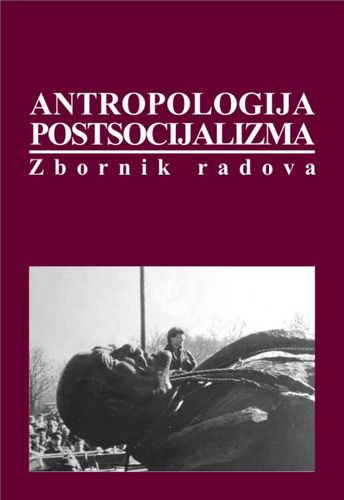
We kindly inform you that, as long as the subject affiliation of our 300.000+ articles is in progress, you might get unsufficient or no results on your third level or second level search. In this case, please broaden your search criteria.

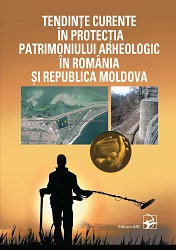
The book is a collection of articles on archaeological heritage preservation in the Republic of Moldova and Romania.
More...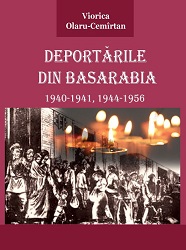
The book on Soviet Deportations in Bessarabia 1940-1941, 1944-1956
More...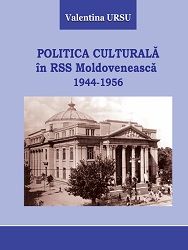
The book on Cultural policy in the Moldavian SSR, 1944-1956
More...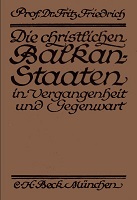
Published in 1916 by C. H. Beck (Munich)The small book offers the text of three lectures the author gave in Leipzig in November and December 1915. In the introduction, the author is noticing, that "among all the current war literature nowhere the topic of his book is really touched while, anyhow, whatever provides information is spread in numerous different works and articles." THE ORIGINAL BOOK IS PRINTED IN GERMAN FRAKTURA LETTERS. PLEASE HAVE A LOOK ON THE TABLE OF CONTENT TO MAKE SURE YOU'LL BE ABLE TO READ. The original has been published 2016 in Leipzig by C. H. Beck Publishing House.
More...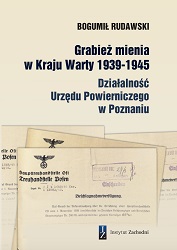
In 19391945, appropriations of assets from Poland’s citizens were a commonplace experience. Appropriations continued throughout the German occupation were part of the planned destruction of people’s existence. At the very beginning of the occupation various property rights of Polish citizens were limited by regulation, and property was seized by way of requisition or confiscation. In the Wartheland, as in all of Poland occupied by the Third Reich, appropriations took place on were a mass scale. They took two basic forms: robbery by German officials and civilians, and official expropriations, which were institutionalised. This second form proved to be more painful. Acts of appropriation were executed by purposefully established institutions of German state administration which organised and confiscated Poles’ assets. Of these institutions, the most important was the Haupttreuhandstelle Ost (HTO), or the Main Trustee Office for the East, which covered Polish lands incorporated into Germany and some other parts of the German Reich. The HTO had several branches in the incorporated lands. In the Wartheland there was established the Treuhandstelle Posen, which had a subbranch in Łódź (Treuhandnebenstelle Litzmannstadt). The HTO and its regional branches formed the main part of the German trustee administration (Treuhandverwaltung). Institutions of this administration had a monopoly on property confiscations. The basic tasks of these institutions were to confiscate non-agricultural property of Polish citizens and to administer it until it passed to its new German owners, who were German settlers.. The HTO and its units expropriated the property from Polish citizens; then property administrators were appointed, and finally the property was transferred to Germans, who were the only group entitled to property allocation. This organised property transfer was one of the most important measures to Germanise the land and “strengthen” the German countenance of the occupied territory. Appropriations of Polish-owned businesses facilitated (despite some limitations) the building of the foundations of the German socio-economic order. Such plunder was motivated by the prospect of material gains. However, racist theories and their introduction in the territories incorporated into the Reich played an important role. The assets seized by the HTO were primarily real property, namely homes, industrial enterprises, shops and small workshops. In transferring them to Germans, the HTO devised a number of administrative procedures which in a sense neutralised the appropriation process and made it appear to be a “normal” administrative practice. The Main Trustee Office for the East was established by Hermann Göring’s decree of 19 October 1939. This document was an attempt to secure Göring’s own economic interests in occupied Poland. The idea of a separate trustee administration was developed in the Office of the Four Year Plan, which Göring headed as plenipotentiary. At the time this was the most powerful economic office in the Third Reich. On 1 November 1939, an official communique was issued announcing the creation of the HTO. Its appointed head was Max Winkler. The activities of the HTO as the main body of the trustee administration can be divided into stages. The first stage lasted until early 1940. In this period the focus was on controlling and subordinating various acts of expropriation and ensuring the dominant role of the HTO in the confiscation process. During this time local branches of the Main Trustee Office for the East were developed. Trustee offices were established in Katowice (Kattowitz), Gdańsk (Danzig, then Gdynia/Gdingen), Ciechanów (Zichenau) and Poznań (Posen). The activities of the HTO did not cover the Generalgouvernement zone. There, on 15 November 1939, Governor-General Hans Frank issued an ordinance establishing a separate trustee administration. Thus the HTO was responsible for managing private property only in the Polish territories that had been incorporated into the Reich. Also at this stage a division of competences was made between Hermann Göring and Heinrich Himmler, as the latter also wished to participate in the expropriations. On 10 November 1939 it was agreed that Himmler would be responsible for agricultural property confiscations and the HTO for all non-agricultural assets. The second period lasted until 1942. Here, the activities of the HTO focused on actual confiscations of assets from Polish citizens. The gains were redistributed and transferred to Germans, who were moved in to settle in the occupied lands. At that time there were also plans to expand the trustee administration to cover the occupied Soviet territories. In 1942, the third ordinance on the HTO limited the sale of expropriated property. This marked the beginning of the HTO’s gradual decline. The main factor which paralysed its activities was that its employees were increasingly being conscripted into the Wehrmacht, and thus the HTO’s plans and activities could not be executed effectively. In addition, in 1943 Göring lost interest in the HTO. In the second half of 1944 the evacuation of the HTO’s branches and agencies began, which in effect meant that the trustee administration ceased working. The Wartheland was a “testing ground” for the organisation and execution of a planned and massive plunder of private assets as an element of economic and ethnic policies. The Treuhandstelle Posen began its operations on 6 December 1939, when its first manager, Hugo Ratzmann, was officially appointed. Initially the whole Wartheland territory was subject to the office’s operations. On 20 January 1940 a subbranch in Łódź was created. Nominally, this was subordinated to the office in Posen, but in practice it was independent and functioned as a separate establishment. On 1 May 1941 an agreement was signed whereby the Treuhandnebenstelle Litzmannstadt was made responsible for thewhole administrative district of Łódź while the office in Poznań was made responsible for the Poznań and Inowrocław (Hohensalza) administrative districts. The subbranch took an active part in the functioning of the Litzmannstadt Jewish ghetto. As a result of the establishment of trustee administration offices in the Wartheland, the appropriation of Polish assets was subjected to standardised criteria. Expropriations followed designed administrative procedures and were overseen by specialised German civil servants. The trustee office in Poznań carried on its operations until January 1945. The trustee office in Posen performed four basic tasks in expropriating non-German assets in the Wartheland. These were: registration and record-keeping of assets, confiscations, provisional administration of confiscated assets by trustees (Treuhänder), and redistribution of the assets. In its first months the office concentrated on its own expansion and on establishing its role as the most important and only institution carrying out expropriations on a mass scale in the Wartheland. Its systematic operations to take over businesses that had already been confiscated by other German authorities – mainly the Chamber of Commerce and district administrators (Landrat) – ended in 1940. At that time the plenipotentiaries for counties (Kreise) played a crucial role in strengthening the office’s position. They represented the office at county level, and were responsible for the registration of assets to be confiscated and for safeguarding already confiscated real and movable property on the office’s behalf. On the pattern of the HTO in Berlin, the trustee office in Poznań had two main departments. During the time of its most vigorous growth, its department of administration had six subdepartments, while the economic department had as many as twelve. Each subdepartment of the economic department was responsible for confiscations of defined types of assets. For example, subdepartment B IVa oversaw the appropriation of industrial enterprises, and subdepartment B V was responsible for craft workshops. Additionally, the diversity of assets taken over motivated the creation of several specialised companies, which acted as receivers of some of the confiscated assets. One of the most important companies was the Auffanggesellschaft für die Kriegsteilnehmerbetriebe des Handels (company for taking over trading enterprises for the benefit of war participants), which bought trading enterprises from the trustee office for German soldiers. Another was the Grundstücksgesellschaft für den Reichsgau Wartheland, GEWA (real estate company), which took control over residential land and properties. The takeover of Polish industrial enterprises, the larger ones in particular, was intended to strengthen the potential of German armament production and to increase the efficiency of the German economy in general. As a result of the trustee administration’s activities, Polish economic enterprises were not only confiscated, but also underwent concentration and transformation processes. This led to changes in the pre-war ownership structures. Many large and smaller enterprises were relocated. The equipment of manufacturing enterprises was destroyed and dispersed. The trustee office also closed and liquidated up to 37% of enterprises in the Wartheland, which it classed as unviable. These were mainly small trading firms and workshops, which were many people’s sole assets and source of income. On 17 February 1941 the second HTO ordinance was issued, and the whole institution was decentralised. The trustee office in Poznań , which until then had been subordinated directly to HTO headquarters in Berlin, was now subordinated to the Reichsstatthalter (governor) of the Wartheland, Arthur Greiser. In addition, HTO’s regional branches could no longer manage economic entities whose value exceeded 500,000 Reichsmarks – these would be managed instead by the authorities in Berlin. In the case of the Wartheland there were 133 such enterprises, which were left in the hands of Göring. According to archived documents, by May 1943 the Treuhandstelle Posen and Treuhandnebenstelle Litzmannstadt had confiscated over 49,000 industrial enterprises, trading establishments and workshops. By the end of World War II this number had risen to around 60,000. The real estate company Grundstücksgesellschaft für den Reichsgau Wartheland took possession of over 400,000 homes. In 1944 the value of the assets taken over by the trustee offices in the Wartheland amounted to 266 million Reichsmarks. Of all of the HTO’s branches, it was those in Poznań and Łódź that generated the highest proceeds: 12% of the HTO’s total proceeds, which by March 1945 totalled 2.1 billion Reichsmarks. To this sum should be added the value of assets taken over by dependent companies, and the value of large enterprises which were not included in the financial statements of the regional branches. Taking these into account, it can be estimated that the value of assets confiscated by the HTO in the Wartheland amounted at least to 450 million Reichsmarks. The plundering policy of the trustee administration caused the total destruction of the private sector economy and the pre-war ownership structure. The ruthless economic exploitation affected all spheres of socio-economic life. It ruined Poland’s national assets and the private property of most Polish families. It was not only material losses that Poles suffered. Excluded from political, cultural and economic life, they were exploited as cheap labour in German enterprises. The appropriation of Polish assets by the HTO and its branches greatly facilitated the ownership transformations and nationalisation of the entire economy in Poland after 1945, as it destroyed the institutional and personal continuity of ownership. The economic and social consequences of the HTO’s policies turned out to be extremely far reaching.
More...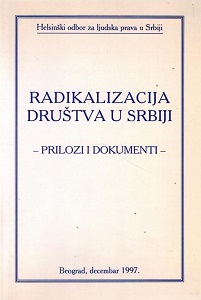
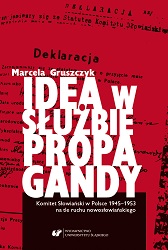
After the Second World War, the cooperation of Slavic people was treated by the communist authorities as the basic determinant of the internal and external policy of the country. It was seen as a guarantee of peace and safety in post‑war Europe. Moreover, according to the recommendations of the Soviet Union, it was supposed to serve the purpose of the Sovietization of the society. Additionally, it was supposed to convince the society about the value of an alliance with the Soviet Union in the eyes of the Slavic nations. The Slavic Committee was the main organization responsible for promoting the idea of Slavic unity. Since it had acquired mass appeal, its activities were supported by Polish‑ Slavic Friendship Societies – mainly by the Polish‑ Soviet Friendship Society. Missing and incomplete data in archival materials makes it impossible to identify the father of the idea of establishing the Slavic Committee in Poland. The only thing that is clear is the fact that the work on its establishment began in June 1945. With an initial focus on national structures, the work was initiated by Warsaw intellectuals, and inspired by communist authorities. Almost at the same time in Kraków, the centre of Slavic studies in Poland, a group of scholars associated with a Jagiellonian University professor – Henryk Batowski – took steps which led to the creation of the first local branch of the association. During his visit in Poland in July 1945, Aleksandr Gundorov, a Soviet activist, recommended the creation of the Polish Committee. He was invited by the Provisional Government of National Unity to take part in the commemoration of the 535th (five hundred thirty fifth) anniversary of the Battle of Grunwald. The most intense period of the operations of the Slavic Committee was between 1945 and 1949, when the committee conducted cultural and educational activities on a great scale. Special attention was accorded to conducting and celebrating public holidays, and historical anniversaries important for Slavs. The committee also organized – with great attention to detail – exhibitions, artistic performances, radio shows, and lectures promoting other Slavic countries. During that time the committee had been heavily involved in the Sorb issue. The involvement was motivated by a broad attention to the problem of the Polish society, and the nation’s strong support in reference to the requirements of the Sorbs. Apart from the element of the strengthening of Slavic unity, it was also a great moment to highlight and explain the defeat of the Third Reich. It is worthwhile to mention that the Committee had its own press organ – Życie Słowiańskie (Eng. Slavic Life) magazine. The monthly appeared between 1946 and 1953. a total of 84 issues were edited and published. An issue contained about 60 pages. Henryk Batowski was the first editor of the magazine. He held this function between 1946 and 1951. Jerzy Woźnicki was the second and, at the same time, the last edit‑ The magazine consisted of two parts. The first one contained articles about the history of Slavic countries (for example, the Soviet Union, the Czech Republic, Bulgaria and Yugoslavia). The content published in the second part was related to Poland. It had the form of short information materials, grouped into regular sections. They included: Kronika polityczna, kulturalna i gospodarcza (Eng. The Political, Cultural and Economic Chronicle) and Przegląd książek i czasopism słowiańskich (Eng. An Overview of Slavic Books and Magazines). Reports on the current activity of the Committee were also printed. Sometimes sports news and information on arts was provided. Texts were mainly written by the members of the Committee management. Officially, the editorial team of the magazine was supposed to make sure that the annual number of published materials on individual Slavic countries was similar. However, most of the published texts were in fact related to the Soviet Union and the Polish‑ Russian cultural cooperation. These were typical propaganda articles, full of lofty slogans praising the alliance with the Soviet Union. In the early 1950s the international cultural exchange has been severely limited. Until that point these activities were in the scope of the Slavic Committee. However, mainly as a result of a Soviet‑Yugoslav conflict they were shifted to the Committee of International Cultural Collaboration (established in June 1950). The Soviet‑Yugoslav conflict ruined the conception of Slavic unity.
More...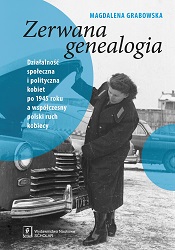
Zerwanej genealogii Magdalena Grabowska proponuje nowe spojrzenie na polskie komunistyczne organizacje kobiece. W tej odważnej, a zarazem dogłębnej analizie Autorka sytuuje ich (zupełnie niedocenione) dokonania w historii feminizmu, będące efektem działań podejmowanych nie tylko w skali krajowej, lecz także międzynarodowej. Szuka również przyczyn marginalizacji organizacji kobiecych z czasów PRL-u we współczesnym polskim feministycznym archiwum oraz spuścizny komunizmu i socjalizmu w światowym ruchu na rzecz równych praw. W pracy wykorzystuje najnowszą literaturę przedmiotu z zakresu gender studies, historii kobiet i historii feminizmu, źródła prasowe oraz wyniki imponujących badań własnych, na które złożyły się zarówno wywiady pogłębione z byłymi działaczkami, jak również archiwalne zapisy posiedzeń organizacji kobiecych i dokumenty ONZ.z recenzji dr hab. Agnieszki KościańskiejDr Magdalena Grabowska - socjolożka, absolwentka wydziału Women’s & Gender Studies na Rutgers University, adiunkt w Instytucie Filozofii i Socjologii PAN. W latach 2010-2014 stypendystka European Commission, Marie Curie International Reintegration Fellow na Uniwersytecie Warszawskim. Współzałożycielka Fundacji na rzecz Równości i Emancypacji STER. Bada głównie historię ruchów kobiecych i emancypacyjnych w Europie Wschodniej z perspektywy postkolonialnych i transnarodowych ruchów feministycznych. Zajmuje się również prowadzeniem studiów zaangażowanych, w tym poświęconych przemocy wobec kobiet, prawom reprodukcyjnym oraz równości kobiet w polityce. Autorka wielu publikacji naukowych zamieszczanych w różnych czasopismach i pracach zbiorowych.
More...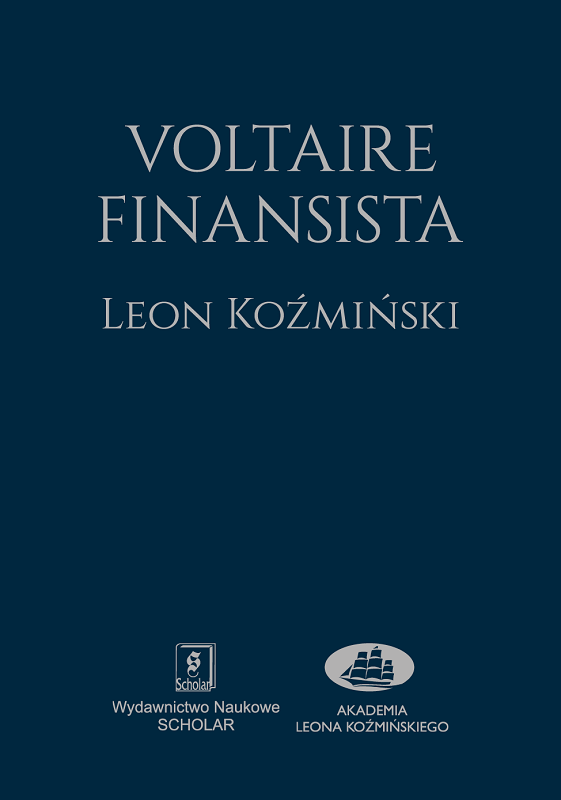
Pierwsza polska edycja monografii Voltaire finansista autorstwa wybitnego ekonomisty, profesora Leona Koźmińskiego (1904–1993). Praca ta została pierwotnie wydana w 1929 roku w języku francuskim i była rozprawą doktorską, za którą Autor – jako pierwszy Polak w historii – otrzymał z wyróżnieniem doktorat des lettres na paryskiej Sorbonie. Praca powstała w wyniku kilkuletnich dogłębnych badań obejmujących nie tylko gigantyczną korespondencję Voltaire’a, ale także materiały prasowe i dokumenty publiczne z epoki, w tym publikacje ekonomiczne, na które powoływał się Voltaire.ze wstępu profesora Andrzeja K. Koźmińskiego Zarówno współcześni Voltaire’owi, jak i potomni podzielili się, jeśli chodzi o opinie na temat motywacji, jakie przyświecały pisarzowi w usilnym oraz niezwykle skutecznym zdobywaniu i pomnażaniu majątku. Monografia Leona Koźmińskiego, którą oddajemy do rąk czytelnika, przytacza niektóre z tych opinii, choć jej celem nie była gruntowna analiza tej właśnie kwestii. Autor zgadza się z tymi, którzy podkreślali, że pieniądze stanowiły dla Voltaire’a zawsze środek, narzędzie, a nie, jak to często bywa, cel sam w sobie.z przedmowy profesora Tadeusza Cegielskiego W Aneksie do książki zamieszczono skan pracy dyplomowej Leona Koźmińskiego, poświęconej działalności osiemnastowiecznego arystokraty-bankiera Antoniego Prota Potockiego.
More...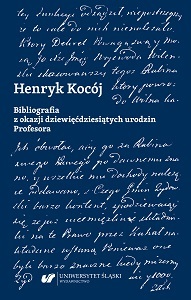
The work is a compilation of Henryk Kocój's bibliography, it also contains his scientific biography and a list of names of his doctoral students.
More...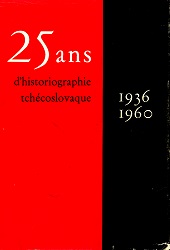
Published in 1960 by the Historical Department of the Czechslovak Academy of Sciences ( NAKLADATELSTVÍ ČESKOSLOVENSKÉ AKADEMIE VÉD )
More...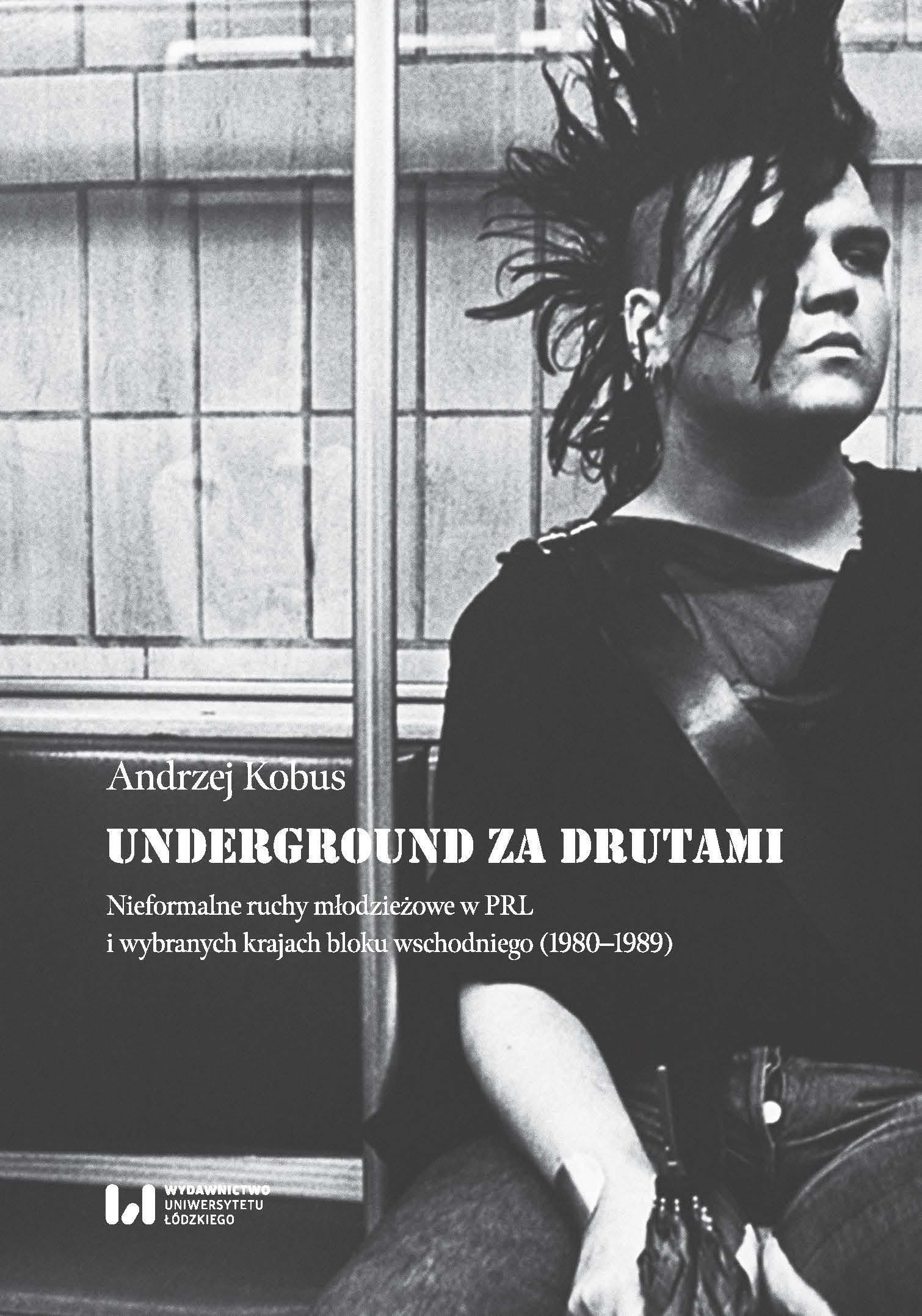
The monograph entitled Underground behind the Wires is devoted to informal youth movements active in the countries of Central and Eastern Europe in the 1980s. The author centres on the countries such as Poland, Czechoslovakia, the German Democratic Republic and the Soviet Union. The monograph sketches the emergence and development of musical subcultures as well as pro-environmental and pacifist youth circles from the aforementioned countries. The progression of informal youth religious movements, both connected with Christianity and Eastern religions, is also described. Particular emphasis is placed on the issues of contacts and cooperation between the circles in question, especially during the crisis and erosion of the communist system in the countries of The Eastern Bloc. The work closes with the elaboration of the position of youth subcultures during the period of political transformations that took place in the countries of Central and Eastern Europe in the 1990s. The content of the monograph is enriched by the visual material in a form of photographs depicting representatives of particular youth subcultures from the discussed Eastern Bloc countries. The security organs were interested in the activities of the circles under discussion, which is illustrated with the scans of the relevant documents.
More...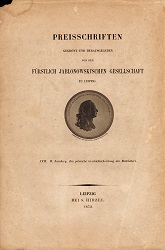
The awarding society had left it up to the applicants to look at the manuscript material themselves and use new ones, either in a similar way to Palacký in his "Appraisal of the Bohemian Historians," or, as Wattenbach had done in "Deutschlands Geschichtsquellen im Mittelalter", to deal with published and elaborated work with independent penetration of the material. The means at my disposal guided me on the second way, but in such a way that, where handwriting was available, this was also used. I felt I had to do this all the more because, as already indicated above, some sources that needed to be discussed have not yet been printed, and the position of some printed sources can only be understood through the manuscripts. The bibliographical evidence also had to be more complete here, where Potthast is not sufficient despite his merits, the presentation, since the work of earlier researchers only served as reliable support in a few cases, often held the middle between those two masters. The nature of both, however - the critical sharpness of the one, the presentation skills of the other - will always remain unmatched and it can be a comfort to those who follow from afar that this confession recently had to be made by a much more important side.
More...
Georgian everyday life is highly tied up with the rich religious traditions that have been developed as a result of the centuries-long synthesis of pre-Christian and Christian practices and worldviews. The Soviet period caused the fragmentation of the traditional religious knowledge and the practice moved to the household level and was paganized. In the post-Soviet period, the burst of religious sentiments and search for identity increased the involvement of big masses to religious practices. The transformations were accompanied by a process of individualization of religion, which has led to a change of forms of religiosity. Based on the ethnographic data of East Georgia, the article discusses the correlation of the normative, vernacular and resistant forms of religiosity. Historical-comparative and parallel analyses are used to research two examples of religious practice: Lomisoba and Berikaoba. Lomisoba is analyzed as an example of hybrid, massive, collective holiday. Berikaoba is more local, not connected to a sacred site, performative festival. It is argued that the contemporary processes are having an impact on the religiosity and the religiosity of certain groups is trying to be defined in new forms. All the old and new forms of religiosity are explicitly displayed and played out in contemporary Georgia. At the same time there are some hidden, or rather implicit practices.
More...
The article introduces to the late medieval romance in verse Vepkhistq’aosani by Shota Rustaveli – the central artefact in Georgian cultural self-awareness and the top item of ‘high’ Georgian cultural export. It briefly presents its narrative content, indicating the correlation of two plot-lines (initially through enframing, after some point though horizontal interlacing). It briefly introduces to the main fluctuations and 20th-century tendency in translating the work’s title, interpreting the fluctuations as indicative of aesthetic differences, and the tendency as an indication of the ‘cultural market’ success of the Soviet-Georgian (in its ideological and aesthetical basis –a Stalinist and socialist-realist) image of Rustaveli’s masterpiece. It presents two influential to dominant claims of Georgian Rustvelology – that the work is a poema (and not a novel/romance) and that it displays, at least partially, Renaissance outlook and poetics, – considering these claims as tools (1) of Soviet “Culture Two” to allot a proper place to Georgian nation within the alternative modernity of the USSR and its premodern background-under-construction, and (2) of Soviet-Georgian cultural nationalism to define a usable past in post-Soviet conditions; and (3) as beliefs. It revitalises the option to contextualise the work of Rustaveli (and, indirectly, Georgian cultural identity) in non-Eurocentric terms, providing some factographic and theoretic clues from the field of macrohistory (J. Abu-Lughod et al.) and a methodological one from sociology of arts (P. Bourdieu).
More...
The article examines, from a historical and contemporary perspective, the processes of valorizing diaspora gardening as local heritage in two significant "gardener villages": Polikraishte and Draganovo (within the municipality of Gorna Oryahovitsa). Based on field studies conducted in Bulgaria and Hungary, the research describes journeys to and from ancestral places, emphasizing their significance and functions in constructing local heritage. The text explores interpretations of diaspora gardening within the settlement's history. In the study, the valorization of gardening as local heritage in Bulgaria is considered a means of establishing connections between the two countries and an integral part of constructing the cultural memory and identity of the Bulgarian community in Hungary.
More...
The purpose of the research is to outline the specifics of Bulgarian gardeners and Bulgarian horticulture in Budapest in the first quarter of the 21 century by means of two examples.Methods of observation, biographical approach, and free and semi-structured interviews are applied. The relationship between Bulgarian horticulture and cultural heritage is analyzed.The study is the result of the author’s participation in a project “Migrations. Modernities, and Intercultural Mediation – Bulgarian Immigrant Groups to Hungary in late 19th and early 20th c. and their Impact on the Social and Cultural Life of the Host Society”.
More...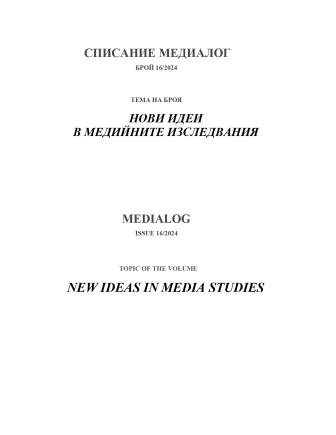
44 scientists participated in the International Scientific Conference dedicated to Prof. Ivaylo Dichev, on the topic: Pop-culture, Pop-politics: The Digital Turn. Interdisciplinary Analyses Of The Intersectionality Between Media, Cultures And Politics. The conference concludes the research project "Pop-culture, pop-politics: The digital turn. Interdisciplinary analyses of the intersection between media, cultures and politics" of the Sofia University. The conference was implemented with the help of the Cultural Studies Network, the journal "Seminar_BG", the Department of "Radio and Television" of the Faculty of Journalism and Mass Communication, and the Department of "History and Theory of Culture" at the Faculty of Philosophy, together with scientists from the Institute of Philosophy and Sociology of the Bulgarian Academy of Sciences.
More...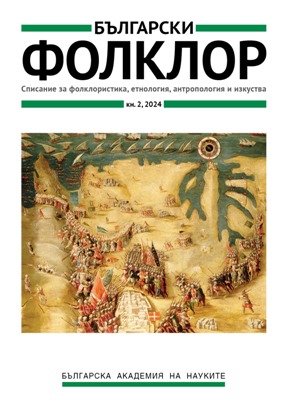
The article summarizes the concepts of historicism of the folklore-poetic works established in our science at the end of the last century. It reviews the recordings and publications of Bulgarian folk songs with the motif "A Virgin Rescues Malta" and examines the research and opinions concerning them. The article also analyses the metadata, associated with the already published versions, throwing more light on the context of their existence at the time of their recording in written form.
More...